Coupled homologous and nonhomologous repair of a double-strand break preserves genomic integrity in mammalian cells
- PMID: 11074004
- PMCID: PMC86559
- DOI: 10.1128/MCB.20.23.9068-9075.2000
Coupled homologous and nonhomologous repair of a double-strand break preserves genomic integrity in mammalian cells
Abstract
DNA double-strand breaks (DSBs) may be caused by normal metabolic processes or exogenous DNA damaging agents and can promote chromosomal rearrangements, including translocations, deletions, or chromosome loss. In mammalian cells, both homologous recombination and nonhomologous end joining (NHEJ) are important DSB repair pathways for the maintenance of genomic stability. Using a mouse embryonic stem cell system, we previously demonstrated that a DSB in one chromosome can be repaired by recombination with a homologous sequence on a heterologous chromosome, without any evidence of genome rearrangements (C. Richardson, M. E. Moynahan, and M. Jasin, Genes Dev., 12:3831-3842, 1998). To determine if genomic integrity would be compromised if homology were constrained, we have now examined interchromosomal recombination between truncated but overlapping gene sequences. Despite these constraints, recombinants were readily recovered when a DSB was introduced into one of the sequences. The overwhelming majority of recombinants showed no evidence of chromosomal rearrangements. Instead, events were initiated by homologous invasion of one chromosome end and completed by NHEJ to the other chromosome end, which remained highly preserved throughout the process. Thus, genomic integrity was maintained by a coupling of homologous and nonhomologous repair pathways. Interestingly, the recombination frequency, although not the structure of the recombinant repair products, was sensitive to the relative orientation of the gene sequences on the interacting chromosomes.
Figures
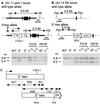
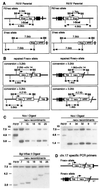
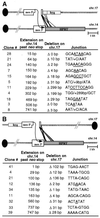
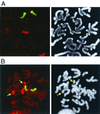
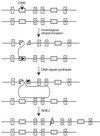
Similar articles
-
Analysis of DNA double-strand break repair pathways in mice.Mutat Res. 2007 Jan 3;614(1-2):95-108. doi: 10.1016/j.mrfmmm.2006.01.022. Epub 2006 Jun 23. Mutat Res. 2007. PMID: 16797606 Review.
-
Extensive loss of heterozygosity is suppressed during homologous repair of chromosomal breaks.Mol Cell Biol. 2003 Jan;23(2):733-43. doi: 10.1128/MCB.23.2.733-743.2003. Mol Cell Biol. 2003. PMID: 12509470 Free PMC article.
-
Double-strand break repair by interchromosomal recombination: suppression of chromosomal translocations.Genes Dev. 1998 Dec 15;12(24):3831-42. doi: 10.1101/gad.12.24.3831. Genes Dev. 1998. PMID: 9869637 Free PMC article.
-
Radiation-induced genomic rearrangements formed by nonhomologous end-joining of DNA double-strand breaks.Cancer Res. 2001 May 15;61(10):3886-93. Cancer Res. 2001. PMID: 11358801
-
Ionizing radiation and genetic risks XIV. Potential research directions in the post-genome era based on knowledge of repair of radiation-induced DNA double-strand breaks in mammalian somatic cells and the origin of deletions associated with human genomic disorders.Mutat Res. 2005 Oct 15;578(1-2):333-70. doi: 10.1016/j.mrfmmm.2005.06.020. Epub 2005 Aug 5. Mutat Res. 2005. PMID: 16084534 Review.
Cited by
-
Strand invasion and DNA synthesis from the two 3' ends of a double-strand break in Mammalian cells.Genetics. 2003 Apr;163(4):1439-47. doi: 10.1093/genetics/163.4.1439. Genetics. 2003. PMID: 12702687 Free PMC article.
-
Multiple functions of Drosophila BLM helicase in maintenance of genome stability.Genetics. 2007 Aug;176(4):1979-92. doi: 10.1534/genetics.106.070052. Epub 2007 May 16. Genetics. 2007. PMID: 17507683 Free PMC article.
-
Quality control of homologous recombination.Cell Mol Life Sci. 2014 Oct;71(19):3779-97. doi: 10.1007/s00018-014-1649-5. Epub 2014 May 25. Cell Mol Life Sci. 2014. PMID: 24858417 Free PMC article. Review.
-
Subtelomeric regions in mammalian cells are deficient in DNA double-strand break repair.DNA Repair (Amst). 2011 May 5;10(5):536-44. doi: 10.1016/j.dnarep.2011.03.001. Epub 2011 Apr 3. DNA Repair (Amst). 2011. PMID: 21466975 Free PMC article.
-
NHEJ-deficient DT40 cells have increased levels of immunoglobulin gene conversion: evidence for a double strand break intermediate.Nucleic Acids Res. 2006;34(21):6345-51. doi: 10.1093/nar/gkl830. Epub 2006 Nov 16. Nucleic Acids Res. 2006. PMID: 17142237 Free PMC article.
References
-
- Belmaaza A, Chartrand P. One-sided invasion events in homologous recombination at double-strand breaks. Mutat Res. 1994;314:199–208. - PubMed
Publication types
MeSH terms
LinkOut - more resources
Full Text Sources
Other Literature Sources
